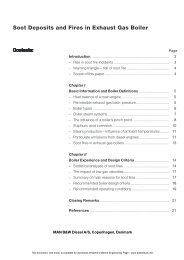Oil Reserves,Transportation,and <strong>Fuel</strong> <strong>Cells</strong>Since 1985, energy use is up• 40% in Latin America• 40% In Africa• 50% in AsiaNo one can predict what willhappen to world wide oil pricesor global oil demand. The world’sproduction of oil reached a recordlevel of 65 million barrels a day in1997, and global demand is risingmore than 2% a year. Americansspend roughly $100,000 per minuteto purchase foreign oil, and the U.S.transportation sector uses over 10%of the world’s oil. Consumption ofoil by passenger vehicles, whichinclude automobiles and light dutytrucks, exceeds all of the UnitedStates’ domestic production. Reservesof fossil fuels are large butfinite, and there is growing evidenceto suggest that world production ofcrude oil will peak early in the 21 stcentury. The Energy InformationAgency forecasts that worldwidedemand for oil will increase 60% by2020. By 2010, Middle East OPECstates (Organization of PetroleumExporting Countries), considered toAnnual oil production (billions of barrels)30252015105WorldWorld projectedWorld outside Persian GulfWorld outside projectedLower 48Projected3.53.02.52.01.51.00.501950 ’60 ’70 ’80 ’90 2000Year01930 ’40 ’50 ’60 ’70 ’80 ’90 2000 ’10 ’20 ’30 ’40 ’50Yearbe unpredictable and often unstable,will have over 50% of the world oilbusiness, and the switch fromgrowth to decline in oil productioncould cause economic and politicaltension. As excess oil productioncapacity begins to decline over thecoming decades, oil prices can beexpected to rise, and the transportationsector is likely to be mostheavily affected by these fluctuations.World wide, transportationrelies almost totally on oil, and thereare few viable short-term fueloptions.Every gallon of gasolinemanufactured, distributed, andthen consumed in a vehiclereleases roughly 25 poundsof carbon dioxide.U.S. oil production in the lower 48 states (upper right) peaked in 1970 aspredicted by a bell shaped curve. World oil production is expected to follow suit.(Courtesy: Science, vol. 281, Aug. 21,1998, p.1128; C. Campbell & J. Laherre`re)Billions of barrels/yearAbout 25% of all human-generatedgreenhouse gases come from transportation— more than half of thatfrom light-duty vehicles. Unlike airpollutants (carbon monoxide,nitrogen oxides, hydrocarbons, andparticulates — soot, smoke, etc.),greenhouse gas emissions (primarilycarbon dioxide, methane, nitrousoxide, water vapor, etc.) fromvehicles cannot be easily or inexpensivelyreduced by using add-oncontrol devices such as a catalyticconverter. In addition, unlike airpollutants, greenhouse gas emissionsare not regulated by the EnvironmentalProtection Agency. Therelationship between gasolineconsumption and carbon dioxideemissions is fixed. Today, increasingfuel economy, reducing vehicle milestraveled, and switching to lower ornon-carbon fuels will begin todecrease carbon dioxide emissions.The introduction of fuel cells intothe transportation sector willincrease fuel efficiency, decreaseforeign oil dependency, and becomean important strategy/technology tomitigate climate change. As fuel cellvehicles begin to operate on fuelsfrom natural gas or gasoline, greenhousegas emissions will be reducedby 50%. In the future, the combinationof high efficiency fuel cells andfuels from renewable energy sourceswould nearly eliminate greenhousegas emissions. The early transition tolower carbon-based fuels will beginto create cleaner air and a strongernational energy security.This document, and more, is available for download at <strong>Martin's</strong> <strong>Marine</strong> <strong>Engineering</strong> <strong>Page</strong> - www.dieselduck.net
Climate Change,<strong>Green</strong>house Gases, and <strong>Fuel</strong><strong>Cells</strong>: What is the Link?There is a growing scientific consensus that increasinglevels of greenhouse gas emissions are changing theearth’s climate. The natural greenhouse gases includecarbon dioxide (CO 2), water vapor (H 2O), nitrous oxide(N 2O), methane (CH 4) and ozone (O 3), and are essentialif the Earth is to support life. With the exception ofwater vapor, carbon dioxide is the most plentiful. Sincethe beginning of the Industrial Revolution in 1765,burning fossil fuels and the increased energy needs of agrowing world population have added man-made, oranthropogenic, greenhouse gas emissions into theenvironment. Carbon dioxide constitutes a tiny fractionof the earth’s atmosphere — about one molecule in threethousand — but is the single largest waste product ofmodern industrial society. The concentration of carbondioxide in the atmosphere has risen from about 280 partsper million by volume to the current level of over 360parts per million by volume and anthropogenicallycaused atmospheric concentration of methane hasdoubled. In the past 100 years, levels of nitrous oxidehave risen about 15%. Increasing concentrations ofgreenhouse gases trap more terrestrial radiation in thelower atmosphere (troposphere), artificially enhancingthe natural greenhouse effect. The average temperatureof the Earth has warmed about 1°C since the mid-19thcentury when measurements began, and fragmentaryrecords suggest the Earth is warmer than it has been innearly 2,000 years.The CO 2 level has increased sharply since the beginning of theIndustrial Era and is already outside the bounds of natural variabilityseen in the climate record of the last 160,000 years. Continuation ofcurrent levels of emissions are predicted to raise concentrations toover 600 ppm by 2100. (Courtesy: Office of Science and TechnologyPolicy)“The balance of evidence suggests that thereis a discernible human influence on globalclimate.”United Nations Intergovernmental Panel on Climate Change, 1995Under the most optimistic scenarios proposed by theUnited Nations Intergovernmental Panel on ClimateChange, carbon dioxide is expected to rise to approximately600 parts per million by volume during the nextcentury — more than double the level held for 10,000years since the end of the last ice age.This document, and more, is available for download at <strong>Martin's</strong> <strong>Marine</strong> <strong>Engineering</strong> <strong>Page</strong> - www.dieselduck.net29

















